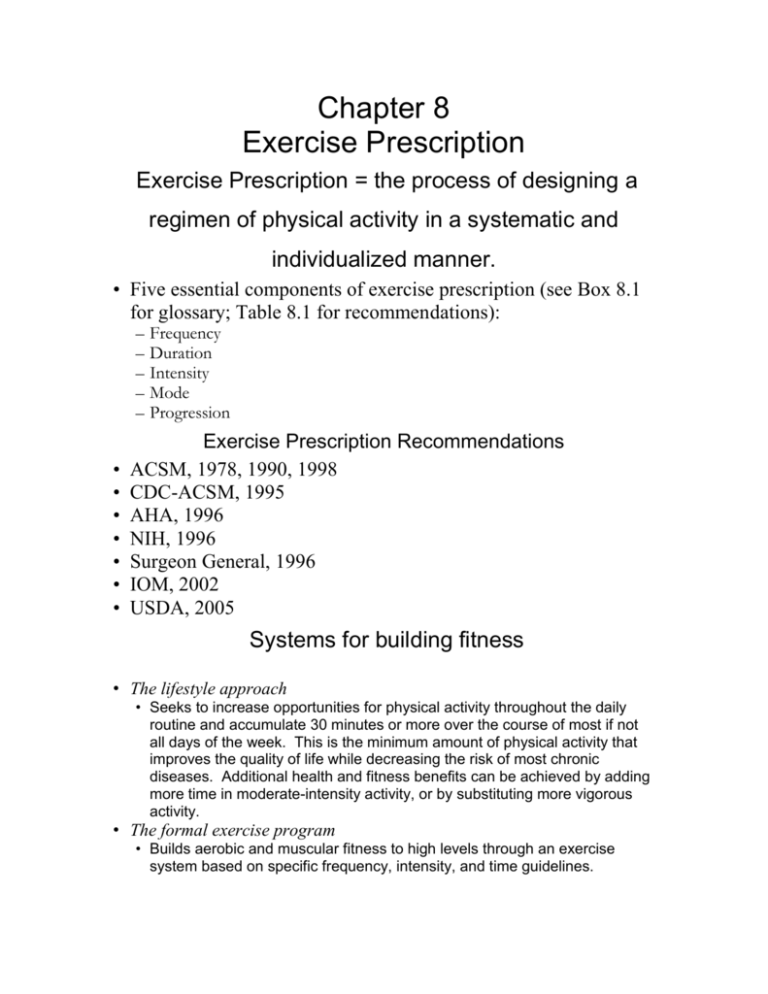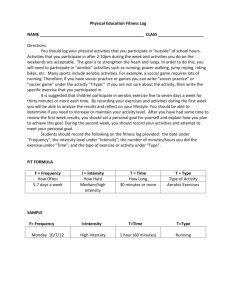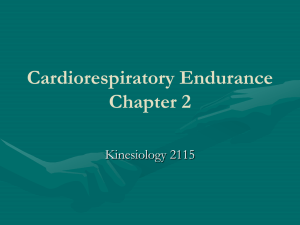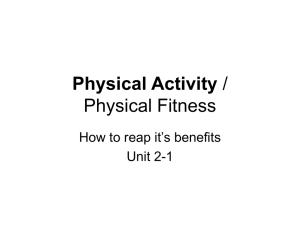Chapter 8 Exercise Prescription
advertisement

Chapter 8 Exercise Prescription Exercise Prescription = the process of designing a regimen of physical activity in a systematic and individualized manner. • Five essential components of exercise prescription (see Box 8.1 for glossary; Table 8.1 for recommendations): – – – – – • • • • • • • Frequency Duration Intensity Mode Progression Exercise Prescription Recommendations ACSM, 1978, 1990, 1998 CDC-ACSM, 1995 AHA, 1996 NIH, 1996 Surgeon General, 1996 IOM, 2002 USDA, 2005 Systems for building fitness • The lifestyle approach • Seeks to increase opportunities for physical activity throughout the daily routine and accumulate 30 minutes or more over the course of most if not all days of the week. This is the minimum amount of physical activity that improves the quality of life while decreasing the risk of most chronic diseases. Additional health and fitness benefits can be achieved by adding more time in moderate-intensity activity, or by substituting more vigorous activity. • The formal exercise program • Builds aerobic and muscular fitness to high levels through an exercise system based on specific frequency, intensity, and time guidelines. Physical Activity Pyramid • The CDC-ACSM lifestyle approach and ACSM formal approach to exercise prescription are components of the same continuum of physical activity recommendations that meet the needs of almost all individuals to improve health status. Review Figure 8.2. Physical Activity Pyramid • The lifestyle approach to fitness is at the base of the Activity Pyramid. This is a good start and brings basic health and fitness benefits. But higher levels of aerobic and muscular fitness can be achieved by working up the Activity Pyramid. • The formal exercise program is summarized on levels 2 and 3 of the Activity Pyramid. – The aerobic or cardiorespiratory stage of a comprehensive physical fitness program consists of three segments: • Warm-up---the 5 to 20 minute transition period that precedes the aerobic exercise session. • Aerobic exercise---brisk walking, swimming, cycling, running, or active sports for 20-60 minutes, 3-5 days per week. • Cool-down—the warm-up in reverse. Keep the feet and legs moving for 5 to 15 minutes after intense exercise by walking, jogging lightly, or cycling slowly. Physical Activity Pyramid (Continued) – Muscular fitness means having strong and enduring muscles, and flexible joints. • Muscular strength and endurance---gained by lifting weights, doing calisthenics, and engaging in hard physical labor (e.g., chopping wood). Perform a minimum of 8-10 separate exercises that train the major muscle groups. Perform one set of 8-12 repetitions of each of these exercises to the point of fatigue, and do this at least 2-3 days per week. • Flexibility---stretch at least 2-3 days a week and involve at least four repetitions of several stretches that are held 10-30 seconds at a position of mild discomfort. • Reduce sitting time. Americans spend far too much time sitting watching TV, playing video games, viewing the Internet, driving cars, and watching other people play sports. Ways to Increase Lifestyle Physical Activity (Box 8.4) • • • • • • • Walk, cycle, jog, or skate to work, school, or the store Park the car farther away from your destination Get on or off the bus several blocks away Take the stairs instead of the elevator or escalator Walk the dog Play sports with the kids Take fitness breaks instead of coffee breaks • Perform gardening, landscaping, or home repair activities • Avoid labor-saving devices as much as practical • Take a walk after supper instead of watching TV Cardiorespiratory Endurance (Box 8.2) • Step 1 Warm-up – Slowly elevate the pulse and body temperature to an aerobic training level by first engaging in 5-20 minutes of easy-to-moderate aerobic activity. • Step 2 Aerobic Exercise – F.I.T. guidelines: Based on current fitness level, follow the F.I.T. guideli » • Frequency (sessions/week) • Intensity (% HR reserve) • Time (minutes/session) Low Fitness 3 40-59% 10-19 Average 3-4 60-74% 20-29 High Fitness 5 or more 75-85% 30-60 – Intensity Calculate personal training heart rate using this formula: – Training heart rate = [(Maximum HR - resting HR) x intensity %] + resting HR – Aerobic Exercise Mode Select 2-3 exercise modes based on personal goals. • Step 3 Cool-down – Slowly decrease the heart rate and body temperature by engaging in mild-to-moderate aerobic activity for 5-15 minutes. Warm-Up • Passive – Use of a warming agent to increase body temperature • Active – Body movements to moderately increase HR and body temperature • An active warm-up should precede vigorous stretching exercises. Aerobic F.I.T. (Frequency, Intensity, Time) • Frequency for formal exercise: – At least 3 times weekly. • Frequency for lifestyle approach: – Accumulate at least 30 minutes physical activity on most, preferably all, days of the week. Intensity • For healthy adults to develop and maintain cardiorespiratory fitness, ACSM recommends that the intensity of exercise be between 50% and 85% of maximum heart rate reserve (HRR), which is approximately the same as 50-85% of maximum oxygen uptake reserve (VO2R) (calculated from the difference between resting and maximum heart rate and resting and maximum VO2, respectively). • If improved health and lowered disease risk is the goal, intensity of exercise can drop to 40%, with duration and frequency becoming the more important standards. • For athletes, the greatest improvements in aerobic power occur when intensity is high (90-100% VO2R). Calculating Exercise Intensity • MET method – Estimate VO2max from an exercise test, and multiple intensity. by desired exercise • Disadvantages: must consult table of MET values for physical activities; environmental factors can alter workload; with improvement in fitness, desired workout MET values change. • Training heart rate method – % HRmax: Underestimates training HR (see Table 8.2). – Karvonen formula, %HRR (see Figure 8.8). This methods relates best to VO2maxR, not %VO2max. • Training HR = [(Maximum HR - resting HR) x intensity %] + resting HR • Best to measure maximum HR and resting HR Figure 8.8 Figure 8.9 Assessment of Training Heart Rate* • • • • The metabolic method (use of METS) (use values from appendix). Measurement of the pulse for 10 seconds (see Table 8.3). Use of the Borg rating of perceived exertion (RPE) scale (see Table 8.5). Use of the talk test. Time • • • Duration of time in minutes that the proper intensity should be maintained to develop VO2max. See Box 8.2 and Figure 8.2 for summary. See Chapter 16 for more information on overreaching and overtraining. • Lifestyle/health approach: Accumulate 30 minutes or more on most days. Mode of Exercise • If frequency, intensity, and duration of training are similar, and a minimum of 200-400 Calories are expended during the session, the training result is independent of the mode of aerobic activity. • See Table 8.6 for a rating of cardiorespiratory exercises, using a “total” fitness emphasis. • See Figure 8.15 from the Surgeon General’s report. Flexibility: 3 basic types of flexibility • Static flexibility – Ability to hold a stretched position (e.g., touching the floor with the fingers with legs straight or performing a “leg split”). • Dynamic flexibility – Ability to engage in slow, rhythmic movements throughout the full range of joint motion (e.g., the ability of a ballet dancer to raise and hold her leg above the head). • Ballistic flexibility – Ability to engage in bobbing, bouncing, rebounding, and rhythmic motions (e.g., touching one’s toes by bobbing up and down). This type of movement is generally not recommended due to injury potential except when included as an inherent part of a sporting endeavor (e.g., certain gymnastic and dance movements). Flexible Benefits (claims) • • • • • • • • More graceful body movements. Enhanced performance of sport skills. Relaxation of mental stress and tension. Muscular relaxation, and relief of muscular cramps and soreness. Improved body fitness, posture, symmetry, and self-image. Reduced risk of low-back pain and other spinal aches and pains. Prevention of injury. Rehabilitation/treatment of pain and injury. An Exercise Program To Build Flexibility (Box 8.8) Step 1 Warm-up aerobically – Never stretch unless the muscles and joints are minutes of moderate aerobic activity. warm from 5-15 Step 2 Follow these minimum flexibility program guidelines: – Frequency: 2-3 days per week, or after each aerobic workout. – Time: hold each position short of the pain threshold for 15-30 seconds, and repeat 24 times (total time, about 15 minutes). Relax totally, letting your muscles slowly go limp as the tension of the stretched muscle slowly subsides. Be sure that you do not stretch to the point of pain to avoid injury and a tightening recoil of the muscle. – Stretching positions: Improve flexibility in several body areas with 8 specific stretching exercises (Appendix). Muscular Strength and Endurance:Total Fitness Workout • A good “total fitness” workout routine that would take about 1 to 1.5 hours to complete could be organized as follows: – – – – Warm-up: 5-10 minutes of easy-to-moderate aerobic activity. Aerobic exercise: 20-30 minutes of moderate-to-vigorous aerobic activity. Cool-down: 5-10 minutes of mild-to-moderate aerobic activity. Stretching: 5-15 minutes of static stretching, emphasizing all major muscle groups and joints. – Weight lifting: 20-30 minutes of weight lifting, one set of 8-12 repetitions of 8-10 different exercises covering all the major muscle groups. Muscular Strength and Endurance • ACSM recommends this minimum muscular fitness training program (see Table 8.7, Box 8.10, and Box 8.11): – 2-3 d/wk (nonconsecutive), minimum of 1 set of 3-20 reps of 8-10 different exercises. – Older people (50-60 yrs of age and above) may want to emphasize lighter weights and more reps (10-15). • Table 8.8 summarizes 2002 ACSM guidelines for novice, intermediate, and advanced resistance training. • Box 8.9 summarizes advanced systems of resistance training. An Exercise Program To Build Muscular Strength and Endurance (Box 8.11) • Step 1 Warm-up aerobically – Never strength train unless the muscles and joints are warm from 5-15 minutes of moderate aerobic activity. • Step 2 Follow these minimum strength training program guidelines: – Frequency: Strength train at least 2-3 days per week. – Set and Reps: Perform a minimum of one set of 8 to 12 repetitions to the point of volitional fatigue for each exercise. – Strength exercises: Perform a minimum of 8 to 10 different exercises that condition all of the major muscle groups. Perform each exercise through a full range of motion. Perform both the lifting and lowering portion of each exercise in a controlled manner. Principles of Weight Training • Overload principle – Strength, endurance, and size of muscle increase only when the muscle performs for a given period of time at its maximal strength and endurance capacity (against workloads that are above those normally encountered). • Progressive resistance principle – The resistance against which the muscle works should be increased periodically until the desired state is reached. • Principle of specificity – The development of muscular fitness is specific to the muscle groups that is exercised, its type of contraction, and the training intensity. Systems of Muscular Strength and Endurance Training • Repetitions to fatigue – When reps are low (3-5), they build greater strength; when high (15-25), they promote endurance (Figure 8.17) • Set – One set is good for beginners, but 3-5 are optimal. • Rest between sets – 1-2 minutes is typical (bodybuilders use less, power lifters more) • Order of exercises – Many systems (see Box 8.9) • Type of exercise – Single joint or multiple joints Figure 8.17 3 Classifications of Muscle Contractions • Isometric – Muscle group contracts against a fixed, immovable resistance • Isotonic – Muscular contraction with movement (Box 8.11; Figure 8.19). • Concentric: muscle contraction with shortening • Eccentric: muscle contraction with lengthening • Isokinetic – Maximal muscle contraction throughout the entire range of motion (see Figures 8.19 and 8.20).







